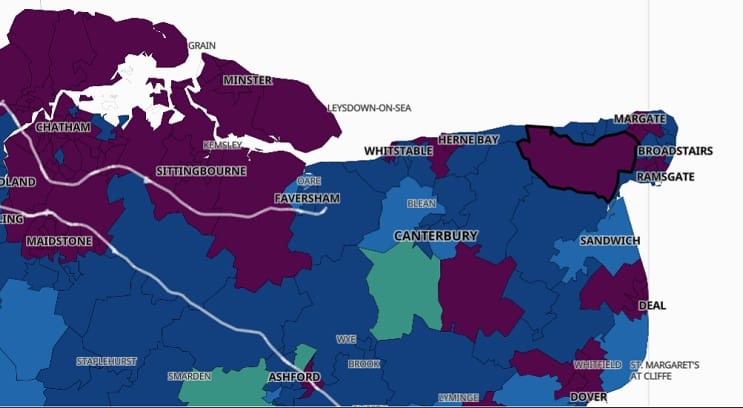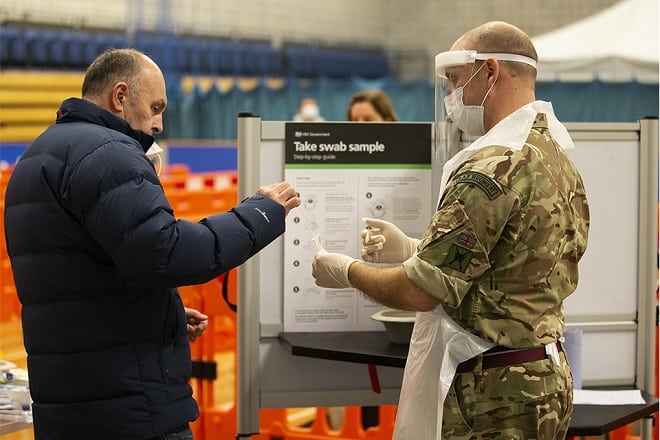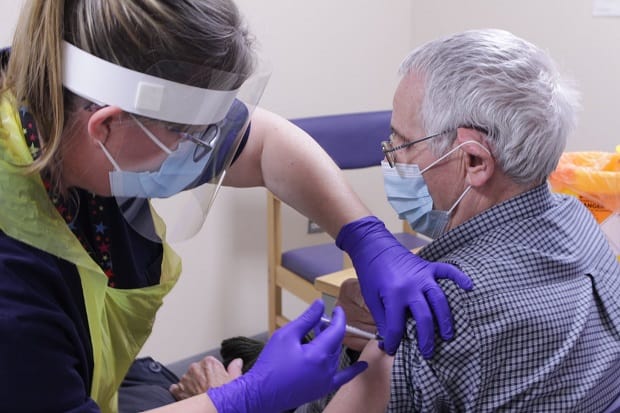
The weekly rate of Covid positive tests per 100,000 people has dropped again in Thanet – the only county district to do so according to Kent County Council data today (December 10).
The figures, which are for 30 November to 6 December, show Thanet as having 400.9 per 100,000, a drop of 74.7 on the previous seven days.
Rates in other districts across Kent show rises with Swale again going above 600 per 100,000 at 611 – an increase of 35.3 on the previous week.
The Kent average stands at 350.3, a rise of 51.3 on the previous week and the England average is recorded as 154.4 which is also a slight rise on the previous week. (See note on data differences at bottom of page).

According to the government covid dashboard the Thanet figure is 422 per 100,000 but this is for the seven days to December 5 – a day’s lag on the Kent data.
Some 4,845 people in Thanet are recorded as having tested positive for the virus.
The dashboard shows 87 new positive tests recorded for today making 589 in the last seven days, a 2.5% drop on the preceding week. There are four deaths recorded within 28 days of a positive test, making 25 losses in the last seven days and a total of 192 losses within 28 days of a positive test up to yesterday.
Covid-19 is mentioned on the death certificate but may not be the primary cause of death.
The figures are updated daily, although there is some time lag on some statistics. They can be found on the government dashboard here and here and on the KCC website here
Tier levels
Despite the slow decline in rates it is unlikely Thanet and Kent as a whole will move out of Tier 3 restrictions when this is reviewed by government on December 16 – meaning hospitality businesses such as pubs and hotels will lose any Christmas trade due to enforced closure or takeaway/delivery services only.
The government’s decisions on tiers is made by ministers based on recommendations by government scientists and medics, taking into account:
- infection rates in all age groups and in particular among the over 60s
- how quickly case rates are rising or falling
- the number of cases per 100,000 in the general population
- pressure on the NHS – including current and projected NHS capacity (admissions, bed occupancy and staff absences)
- local factors and exceptional circumstances such as a local but contained outbreak.
Kent and Medway Clinical Commissioning Group has opened more critical care beds for Covid patients.
A statement from the CCG says: “All hospitals across Kent and Medway continue to be under significant pressure due to the high rates of infection in the local communities.
“We have opened more critical care beds to support Covid-19 patients, and will be opening more. We’re continuing to provide cancer and other urgent operations. However, we are now pausing non-urgent elective services. This will allow staff to move to support the increased number of Covid-19 patients.
“Initially this will be for a two week period. We will keep this under weekly review and will contact individual patients where appointments need to be rescheduled.
“Reports in the media that some intensive care units are full are misleading. The numbers of patients in intensive care can change on a daily or hourly basis and all hospitals are working together to make sure the most seriously ill patients are cared for. If a unit is using all of its beds at any given time we have systems in place to transfer or redirect patients.
“It is really important that everyone follows all the Covid-19 guidelines to stop the spread. This is to protect yourself, your loved ones and to help reduce the number of people needing hospital care.”
Hospital data
Data from East Kent Hospitals (via NHS England) shows there are 121 occupied Covid beds as of December 1 at the main sites (Margate, Ashford and Canterbury). This is down from 173 on November 30. Of those 16 mechanical ventilation beds are in use, down one from November 30. East Kent Hospitals Trust has recorded 563 covid related deaths (see footnote).
Asymptomatic testing

Military support will be used to create asymptomatic testing sites in Thanet and Swale. The programme is to be rolled out in areas of high prevalence in Kent in the coming weeks.
This helps to identify those people who may have the coronavirus without symptoms and who are therefore potentially spreading it unknowingly within their families and local communities.
The first asymptomatic testing sites have been identified for Swale and Thanet due to the current high prevalence in those areas, and further sites are being investigated in other districts.
Lateral flow testing will help to reduce case numbers in those areas and get back to manageable levels of the virus, and place Kent in a better position to move out of Tier 3.
People without symptoms of COVID-19 will be invited to these sites, for a lateral flow test. This is a swab test, but unlike PCR where a laboratory and specialist equipment is needed, the result is given within 30 minutes. KCC will be launching a recruitment drive to run the testing sites, along with redeploying existing workforce where possible.
The Government has also already begun lateral flow testing in settings that are most vulnerable – for example care homes and NHS – across Kent.
This testing is being funded by central Government to support local councils to manage the second wave of the pandemic.
Vaccine

The NHS began its vaccination programme with the Pfizer/BioTech vaccine this week.
People aged 80 and over as well as care home workers have been first to receive the jab, along with NHS workers who are at higher risk.
There are 50 hubs in the first wave – including the William Harvey Hospital in Ashford – and more hospitals will start vaccinating over the coming weeks and months as the programme expands.
GPs and other primary care staff are also being put on standby to start delivering the jab. A small number of GP-led primary care networks will begin doing so week beginning 14 December with more practices in more parts of the country joining in on a phased basis during December and in the coming months.
Weekly cases per 100,000 people by district (KCC data)
Ashford 278.5 +101.5 vs previous 7 days
Canterbury 346.4 +88.9 vs previous 7 days
Dartford 294.0 +55.1 vs previous 7 days
Dover 389.5 +77.9 vs previous 7 days
Folkestone and Hythe 293.8 +71.7 vs previous 7 days
Gravesham 454.5 +65.5 vs previous 7 days
Maidstone 419.0 +36.1 vs previous 7 days
Sevenoaks 140.8 +15.7 vs previous 7 days
Swale 611.0 +35.3 vs previous 7 days
Thanet 400.9 -74.7 vs previous 7 days
Tonbridge and Malling 298.1 +73.4 vs previous 7 days
Tunbridge Wells 191.2 +86.8 vs previous 7 days
What KCC says about its covid data: Data shows the number of COVID-19 cases in the 7 day period stated. This provides a better indication of local trends than individual daily figures, which can fluctuate considerably from day to day. Figures are given as a rate per 100,000 people to make comparisons between different areas more meaningful.
The smaller number below the main figure shows the change compared to the previous 7 days (for example 13 to 19 November would be compared to 6 to 12 November).
To provide a more complete picture of what the data tells us, we use a full week’s data. COVID-19 test results typically take a few days to show up in the data we use and so this can make figures for the most recent days appear lower than they really are. For this reason, we do not include data for the most recent 4 days.
Rates may differ slightly from those published by Public Health England as these are produced as a snapshot in time, and do not include cases that were confirmed later on. Other sources may publish figures for different time periods and so they may not match ours.
Details of Covid attributed deaths data: NHS England and NHS Improvement publish the number of patients who have died in hospital and tested positive for COVID-19 in England. Since Tuesday 28 April, NHS England and NHS Improvement also reports the number of patient deaths where there has been no COVID-19 positive test result, but where COVID-19 is documented as a direct or underlying cause of death on part 1 or part 2 of the death certification process. This change has been introduced for deaths that occurred on 24 April and subsequently.

